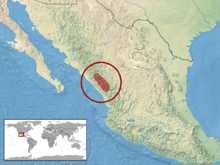Crotalus stejnegeri
| Crotalus stejnegeri | |
|---|---|
| Scientific classification | |
| Kingdom: | Animalia |
| Phylum: | Chordata |
| Subphylum: | Vertebrata |
| Class: | Reptilia |
| Order: | Squamata |
| Suborder: | Serpentes |
| Family: | Viperidae |
| Subfamily: | Crotalinae |
| Genus: | Crotalus |
| Species: | C. stejnegeri |
| Binomial name | |
| Crotalus stejnegeri Dunn, 1919[1] | |
 | |
- Common name: Long-tailed rattlesnake[2]
Crotalus stejnegeri is a venomous pit viper species found in western Mexico. No subspecies is currently recognized.[3]
Etymology
The specific name, stejnegeri, is in honor of Leonhard Hess Stejneger, herpetologist at the Smithsonian Institution for over 60 years.[4]
Description
Adults do not usually grow to more than 60 cm (24 in) in length. The greatest length recorded for a specimen is 72.4 cm (28.5 in). The tail is relatively long, representing 11-14.8% of the total length of adult male snakes and 9.8-12.5% in females. Klauber (1940) suggested, since the rattle is tiny, it is probably not audible. A very rare species, it is known only from about 12 specimens.[2]
Geographic range and habitat
It is found in western Mexico in the mountains and foothills of eastern Sinaloa, western Durango and probably northern Nayarit, between 500 and 1,200 metres (1,600 and 3,900 ft) in altitude. The type locality given is "Plumosas [Plomosas], Sinaloa, Mexico".[1] It occurs in pine-oak forest, subtropical dry forest and tropical deciduous forest.[1]
Conservation status
This species is classified as Vulnerable on the IUCN Red List of Threatened Species with the following criteria: B1ab(iii) (v3.1, 2001).[5] A species is listed as such when the best available evidence indicates its extent of occurrence is estimated to be less than 20,000 km2 (7,720 mi2), estimates indicate it is severely fragmented or known to exist at no more than 10 locations, and a continuing decline has been observed, inferred, or projected in its area, extent, and/or quality of habitat. Therefore, it is considered to be facing a high risk of extinction in the wild. The population trend was down when assessed in 2007.[6]
See also
- List of crotaline species and subspecies
- Crotalus by common name
- Crotalus by taxonomic synonyms
- Crotalinae by common name
- Crotalinae by taxonomic synonyms
- Snakebite
References
- 1 2 3 McDiarmid RW, Campbell JA, Touré T. 1999. Snake Species of the World: A Taxonomic and Geographic Reference, vol. 1. Herpetologists' League. 511 pp. ISBN 1-893777-00-6 (series). ISBN 1-893777-01-4 (volume).
- 1 2 Campbell JA, Lamar WW. 2004. The Venomous Reptiles of the Western Hemisphere. Comstock Publishing Associates, Ithaca and London. 870 pp. 1500 plates. ISBN 0-8014-4141-2.
- ↑ "Crotalus stejnegeri". Integrated Taxonomic Information System. Retrieved 1 August 2007.
- ↑ The Reptile Database. www.reptile-database.org.
- ↑ Crotalus stejnegeri at the IUCN Red List. Accessed 13 September 2007.
- ↑ 2001 Categories & Criteria (version 3.1) at the IUCN Red List. Accessed 13 September 2007.
Further reading
- Dunn, E.R. 1919. Two New Crotaline Snakes from Western Mexico. Proc. Biol. Soc. Washington 32: 213-216.
External links
- Crotalus stejnegeri at the Reptarium.cz Reptile Database. Accessed 12 December 2007.
